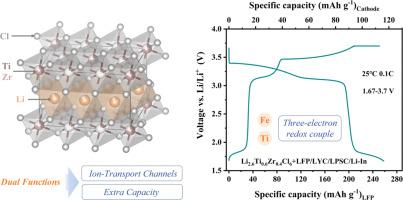Advanced Ti-based multi-electron pair electro-active solid halide electrolyte for all-solid-state lithium batteries
IF 20.2
1区 材料科学
Q1 CHEMISTRY, PHYSICAL
引用次数: 0
Abstract
The development of high-energy-density all-solid-state lithium batteries (ASSLBs) hinges critically on the design of advanced composite cathode components. While significant progress has been made in optimizing solid electrolytes as separators, the advancement of catholytes—particularly those combining multi-electron pair redox activity, high ionic conductivity, and mechanical compressibility—remains underexplored. A key challenge in current composite cathodes is the non-negligible high loading of electro-inactive electrolytes, which drastically reduces the energy density of the ASSLBs. To address this limitation, we propose an alternative strategy to improve the energy density by using Li2.6Ti0.6Zr0.4Cl6 as an electro-active catholyte with multi-electron pair. This material exhibits exceptional ionic conductivity (1.39 mS cm–1 at 25°C) while simultaneously delivering a highly reversible specific capacity of approximately 90.62 mAh g–1. Aliovalent Ti substitution enhances ionic conductivity through a structural transition from high-symmetry to low-symmetry space groups, coupled with a crystallinity strengthening effect. Moreover, the composite cathode of Li2.6Ti0.6Zr0.4Cl6 and LiFePO4 reveals an impressive initial discharge capacity of 258.97 mAh g–1LFP. This work introduces a new type of functional electro-active catholyte, significantly enhancing the energy density and cost-effectiveness of ASSLBs, opening new avenues for the development of next-generation solid-state battery technologies.

全固态锂电池用新型钛基多电子对电活性固体卤化物电解质
高能量密度全固态锂电池(ASSLBs)的发展关键在于设计先进的复合阴极组件。虽然在优化固体电解质作为分离器方面已经取得了重大进展,但阴极电解质的发展,特别是那些结合多电子对氧化还原活性、高离子电导率和机械压缩性的阴极电解质,仍有待探索。目前复合阴极面临的一个关键挑战是不可忽略的高负荷电非活性电解质,这大大降低了assb的能量密度。为了解决这一限制,我们提出了一种替代策略,即使用Li2.6Ti0.6Zr0.4Cl6作为具有多电子对的电活性阴极来提高能量密度。该材料具有优异的离子电导率(25°C时为1.39 mS cm-1),同时具有约90.62 mAh g-1的高可逆比容量。价钛取代通过从高对称到低对称空间基团的结构转变增强离子电导率,并伴有结晶度增强效应。此外,Li2.6Ti0.6Zr0.4Cl6和LiFePO4复合阴极显示出令人印象深刻的初始放电容量为258.97 mAh g-1LFP。这项工作引入了一种新型的功能性电活性阴极,显著提高了asslb的能量密度和成本效益,为下一代固态电池技术的发展开辟了新的途径。
本文章由计算机程序翻译,如有差异,请以英文原文为准。
求助全文
约1分钟内获得全文
求助全文
来源期刊

Energy Storage Materials
Materials Science-General Materials Science
CiteScore
33.00
自引率
5.90%
发文量
652
审稿时长
27 days
期刊介绍:
Energy Storage Materials is a global interdisciplinary journal dedicated to sharing scientific and technological advancements in materials and devices for advanced energy storage and related energy conversion, such as in metal-O2 batteries. The journal features comprehensive research articles, including full papers and short communications, as well as authoritative feature articles and reviews by leading experts in the field.
Energy Storage Materials covers a wide range of topics, including the synthesis, fabrication, structure, properties, performance, and technological applications of energy storage materials. Additionally, the journal explores strategies, policies, and developments in the field of energy storage materials and devices for sustainable energy.
Published papers are selected based on their scientific and technological significance, their ability to provide valuable new knowledge, and their relevance to the international research community.
 求助内容:
求助内容: 应助结果提醒方式:
应助结果提醒方式:


